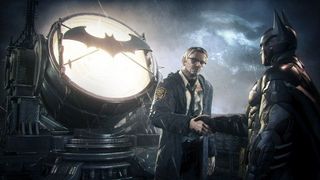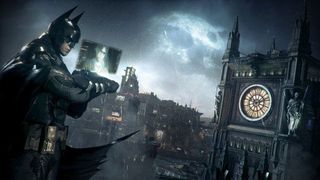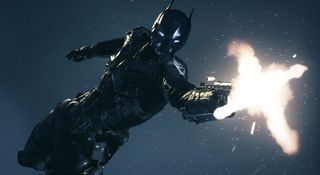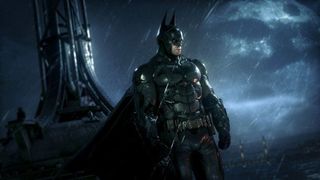Batman: Arkham Knight first-look: new villains, a bigger city and the Batmobile

The Batmobile. They've done it! Rocksteady have resolved the last major tenet of Batman lore. The Caped Crusader's high-tech vehicle tears around Gotham City tearing down barriers, firing (non-lethal) rockets, and roars towards him on autopilot.
Arkham Knight's Batmobile is a little bit Nolan trilogy and futuristic-looking, too, maintaining Rocksteady's notable history of creating a Batman world that sits neatly alongside those in other media without replicating them. But the best thing about this one is the animation of the car. Each wheel moves individually, bouncing up and down depending on the shape of the environment. It's a ferocious toy, even though I can't quite figure out its place in Arkham's delicately balanced game systems based on this first reveal.
Batman in the Batmobile looks like Burnout, a seething maniac rocketing around at a high speed and pancaking rival cars, to borrow some Nolan parlance. It has a booster on the back. It can crash through the wall of a freeway and land metres below on another road. The Batmobile looks pretty, but the demo doesn't reveal much beyond the usual remit of a vehicle's function in an otherwise polished open world game. But then it is early days, and I'm possibly playing down how exciting it will be to finally drive the Batmobile in a game that isn't rubbish (or Lego Batman 2).

The part of the game I'm shown has Batman seeking a mysterious military vehicle, a search he begins by meeting Jim Gordon on the roof of the GCPD. The first view we get of the city is extraordinary – it's 20 times bigger than Arkham Asylum, Rocksteady say, which isn't hard to believe given the thickly detailed sprawl of grimy, almost Blade Runner-esque high-rises illuminated across the horizon by night lights (it's raining too).
Giant GCPD airships patrol the city – a standard part of the iconography in Batman comics and the opening credits of the '90s animated series. The city has been mostly evacuated as the Scarecrow plots an attack involving the majority of Batman's rogues gallery.
It's an elaborate plot device dreamed up to keep the streets as a criminal's playground devoid of civilians, but it's hardly a less plausible premise than a man dressed as a bat and his remote-controlled tank hunting for men themed respectively around a penguin and a scarecrow.
This is clearly a much bigger job for Rocksteady than previous Batman games were, creating the entirety of Gotham City and incorporating the Batmobile. I asked Rocksteady's Dax Ginn whether the studio had to rework the way they thought about environmental design to build a city this big.
The biggest gaming news, reviews and hardware deals
Keep up to date with the most important stories and the best deals, as picked by the PC Gamer team.

“For us in the past, it's been one way or the other,” ha says. “The detail we put into creating Arkham Asylum was critical to the atmosphere of that game. Then in Arkham City, we just blew the doors off and went open world. It was really a balance of how big we could go and how detailed we could execute [the world].”
It does look incredible, like a grid of environments equally as detailed as Arkham City's semi-Gotham but laid out in GTA-esque fashion. One adaptation made for the increased size of the world is gliding, now sped up to the point that it's aerodynamically impossible (again, man in a bat suit — logic has no place here). The same principles of City's gliding apply, in the way that swooping a downwards arc then pulling up will give you a boost that allows you to continue gliding longer, but the effect is now exaggerated as Batman sails over multiple streets.
The presentation of the story has seen a significant upgrade, too. When Batman meets Jim Gordon on the station roof, we get to see a cutscene in Arkham Knight's refined art direction, now with realistic characters who are nontheless a little bit more stylised and less chunky than in previous games. Rocksteady mention that the dynamic between Batman, Jim Gordon and his daughter Barbara is an important part of the story. Since I'm still figuring out what Arkham Knight's moment-to-moment narrative actually is outside of slapping down a rogues' gallery greatest hits list, I ask about this.
“It's significant,” says Ginn. “It's the opportunity to really focus on Batman's emotional state and what drives Batman as a man, not as a hero, and we've never done that before. And Oracle has only ever been a voice in Batman's ear. To physically bring her into the game and use her as a character to help us analyse and understand how Batman is feeling from an emotional perspective is really exciting. This is our largest game, but it's also our most emotional.” In the demo, Jim offers information that leads Batman to an officer in trouble – Oracle gets him a location and he heads over there.

Rocksteady are quiet on other story details. Arkham City left three main unresolved threads: what happened to the now Bruce Wayne-faced Hush, the foreboding dialogue of Azrael, and the teasers about Scarecrow. Hopefully the latter will manifest itself in more compelling narrative asides that play with the boundaries of the fiction, in the fashion of Asylum.
Ginn is more voluble about the changes that have been made to the combat system, which will now see Batman fighting off crowds of up to 50 baddies. “This is all out civil war on the streets of Gotham City,” he says, “so the threat Batman faces when he comes up against gangs of thugs, or the Rogue's Gallery teamed up under Scarecrow, means the combat system has to step up to face that threat, so that's the design process we go to.”
I ask Ginn about making additions to a combat system that was already very well balanced in City. They certainly haven't reinvented the way freeflow works: it looks almost exactly the same when Batman starts beating up a group of thugs in the street, although the animation looks new and Bruce now executes a laughably brutal elbow ground pound as a finisher. You can, however, now begin a combo in mid-air.
“The connection between Batman's combat system and Batman's gadgetry is something we always try to push, so we've got a new philosophy in Arkham Knight, which is gadgets while gliding. You can glide into a fight throwing batarangs while delivering the first two or three blows, then go straight into freeflow combat, so that's the way we think about supercharging the combat experience.” In Batman's inventory, there will have some sense of continuity to previous games too, Ginn tells me – so hopefully players won't be starting from scratch as they rebuild the contents of Bruce Wayne's utility belt.

These strategic ideas are much more valuable than arbitrarily changing the hand-to-hand combat, something illustrated by Arkham Origins' ill-fitting electric fists. When the location of the officer in need is confirmed by Oracle, seeing Batman swoop in to save him while bombarding foes with batarangs adds an energy to the combat build-up that wasn't there before. After helping the injured officer, the military vehicle Batman was searching for suddenly appears and tries to take him out. With the officer secure, Batman summons the Batmobile with the panel on his arm. A chase ensues through the mostly-quiet streets, with Batman bombarding the attacker with immobiliser rockets. The vehicle is totalled.
Climbing out of the Batmobile, Batman interrogates the driver. “If you're lying, I'll break the other one,” growls the Dark Knight, reassuringly voiced again by the brilliantly gruff-but-not-Bale-gruff Kevin Conroy. “Other what?” asks the perp, before Batman breaks his arm.
The demo is designed to give us a crosssection of everything going on in Arkham Knight. Next up is the Riddler, whose challenges were such an integral part of the previous two games' extra lifespan. Edward Nigma's challenges see Batman heading underground to take part in races against the clock, with obstacles to overcome along the way, and I don't really see the appeal on this first showing. I do like the Riddler's slightly cheeky declaration that this is the 'next generation' of his challenges to Batman, though.
On a more optimistic note, stealth has been approached a bit like combat: small improvements rather than reinvention. A new move we're shown is the fear takedown, which solves the longstanding annoyance of Batman being powerless against gunmen – it allows him to tackle three at once with well-timed button presses. The screen goes into slo-mo before each attack, and watching Batman sprint between three armed goons is satisfyingly different from the rest of his moveset. I'm later told by Ginn that these attacks require player coordination, and the enemies have to be gathered into close proximity first, which ensures the system remains balanced.

After more Batmobile hijinks – we're shown that ejecting while driving creates a neat gliding boost – the last moment of the demo sees Batman ambushed by the titular Arkham Knight, an original character created by Rocksteady in collaboration with DC Comics. He's best described as Batman via Optimus Prime in his slightly robotic blue demeanour, like a '90s comic creation who could've emerged from the same school of thought that gave us Bane, Doomsday, Kyle Rayner and Superman with a mullet. He or she also violates Bruce Wayne's Batman ruleset by running about with a pistol. We're left to speculate on the Arkham Knight's identity, though. Alfred?
The Batmobile is the clear star here – and I'm keen to learn more about how progression can keep the vehicle feeling fresh for the entire arc of the story, which was key to the longevity of combat and stealth. Ginn promises this is part of the deal. “The Batmobile itself is like a massive gadget. It has character, personality and that emotional connection to Batman as well. But we really wanted to ensure that players have that sense of progression with it. We've shown one on-board gadget here, the immobiliser rocket, which is a nonlethal vehicle takedown.” There's a lot more for us to learn about it, apparently, but Gotham is structured to support the Batmobile – this isn't a horseshoe hub like Arkham City, it's a huge fully-functioning environment. It's breathtaking. It feels like this, along with The Witcher 3, could show us exactly what to expect from the future of open-world games in the obsessive construction of these landscapes.
This may not please the subset of fans who believe the focus of Arkham Asylum made it superior to City – obviously the narrative scope of Arkham Knight only broadens with a world of this size, and Ginn tells me that sidequests will be more organically integrated into the way players go through the world. But there's a flooring amount of detail in Rocksteady's far-reaching noir city, and even touches like the reflective water effect on Batman's cape are notably advanced.
The Batmobile is the final piece of the Caped Crusader's legacy on the table for Rocksteady, and it's the right way to close out a series that has interpreted the rest of Batman's mythology without compromise. There are still a lot of specifics about the vehicle that could use explanation, but it makes an audacious first impression, and shows how effective Rocksteady are at setting themselves ludicrously tough goals for creating an authentic Batman game.
Most Popular


